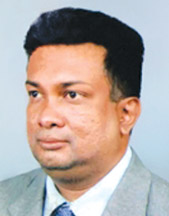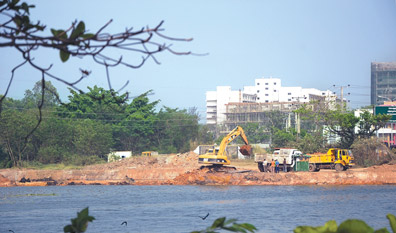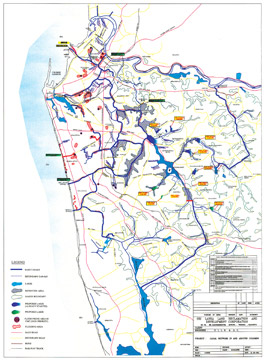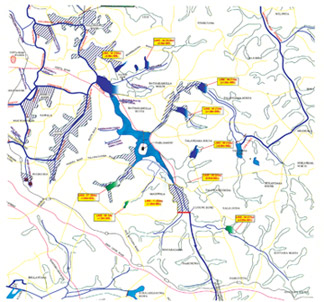|
Flood control in Colombo:
SLLRC’s mission nearing completion
by Ranil Wijayapala
|

Harshan de Silva
|
The severe floods that hit the greater Colombo areas in May and
November 2010 were an eye opener for many in Colombo. It brought to mind
the badly maintained canals and drainage systems in the commercial
capital Colombo and the administrative capital Sri Jayawardhanapura,
Kotte.
Members of Parliament had to wade through the waters of the Diyawanna
as it inundated all the access roads to the legislature covering the
ground floor of parliament building fully on November 11. It became a
matter of grave concern for the authorities to think afresh, to find
short-term, medium-term and long-term solutions to the flooding in
Colombo and suburbs.
It was the Land Reclamation and Development Corporation (SLLRC) which
was listed under the Ministry of Defence, in the Cabinet reshuffle
following the 2010 general election, that took the lead along with other
relevant agencies to think of a solution to this problem.
A Chartered Architect Harshan de Silva who was appointed Chairman of
the SLLRDC in May 2010, was the one who had to lead the fight against
floods in Colombo. The process was in itself a war to control floods as
it affected the lives of the poorest of the poor living in shanties and
the richest of the rich living in mansions.
 |
|
Dredging in progress |
It was a long and arduous process to rectify the ills in the drainage
system the canals and sub canals.
The main canal system in the Colombo basin had six outfalls to drain
the water collected in the Dehiwela, Wellawatta, St. Sebestian’s,
Kolonnawa Ela canals into the sea. It was through the outfalls at
Dehiwela, Wellawatte and the Beira Lake that the Galle Face green and
MacCalum Road and Colombo Port connected those canals directly into the
Indian ocean.
The
outfalls at Mutuwal, Nagalagam Street and Ambatale connected the canals
in Colombo North to the Kelani River.
“We had to see the quantity of water flowing through these outfalls.
The entire canal system had not been dredged in one run for years,” de
Silva said.
One major problem we faced was that there was no allocation of funds
for the dredging of the entire canal system in one run by the treasury.
|
 |
|

Retention areas in Greater Colombo |
When the treasury allocates funds they give a limited amount of money
and with that money the SLLRC can dredge only a segment of a canal.
They used to dredge parts of each canal according to the allocation
of funds but not the entire thing at once.
“That was something which I thought which we lack. If we take the
entire canal system - 1 Metre Mean Sea Level you have to do dredging of
the entire canal network. If you do the dredging only in one part of a
canal it is useless.
You have to dredge the whole canal at once”, de Silva said.
The SLLRC studied the root causes for the flooding and the Defence
Secretary, Gotabhaya Rajapaksa formed a Task Force under the
Chairmanship of SLLRC Chairman Harshan de Silva to look into the matter
on priority basis.
The Coast Conservation Department, Irrigation Department, Land
Reclamation and Development Corporation, Urban Development Authority,
Forest Department, Wild Life Department and all Local Authorities were
members of this task force and they met every week to discuss the issue.
“After about two months we found 44 locations which have to be
addressed and we had to address them pretty soon,” he said.
To address the immediate issue we did a survey at Devi Balika
Junction, D.S. Senanayake Junction and Colombo University where there
were no canals or rivers, places that were inundated due to flash
floods.
“It was due to various technical issues that these areas went under
water and some of them went into the short-term and medium-term slots,”
he said.
To address the immediate issues the SLLRC worked with the Colombo
Municipal Council. Its Special Commissioner Omar Kamil and Commissioner
Badrani Jayawardene did a great job with all other organisations and
institutions came up to address the 44 issues.
To control floods around Devi Balika Vidyalaya a peripheral drain was
constructed in Manning Town and Health grounds.
“Now we are looking at penetrating the Castle Hospital and we have to
connect that drain into the Heen Ela that goes behind the Golf grounds”
de Siva said.
The floods close to Devi Balika Vidyalaya stalled traffic along
Parliament drive and beyond Malabe town creating transport problems and
other issues.
“Like this project the SLLRC along with other agencies had to address
many isolated places where flash floods were reported. We had to address
them under the short-term and medium-term projects, he said.
The SLLRC managed to complete the short-term projects during May to
December 2010.
When addressing those issues the SLLRC had to face certain
restrictions with regard to manpower, financial issues, fuel allocation
and the supervision and monitoring of the work. It was the Defence
Secretary Gotabhaya Rajapaksa who helped resolve those issues.
“I got about 500 personnel from the Sri Lanka Navy to work on the
canals.
The Sri Lanka Air Force helped me to do the surveillance and
monitoring on air. The Army also helped providing us with security and
the Police assisted us to go ahead with our work. That I think was a big
way forward for us,” he said.
To dredge the entire canal network the SLLRC needed a lot of
machines. The Corporation machines which were idle for years were
repaired and barges were welded by the Navy along with the workers of
the SLLRC.
A huge amount of money for the entire project was allocated from the
Defence Ministry budget.
“People may ask why we need this much of money for the defence budget
since there is no war. Now this is the types of work the Ministry of
Defence is doing,” he said.
The process of dredging was monitored. “For all these machines we had
Navy personnel monitoring fuel consumption, meters and the manpower.
Nothing went astray. My audit team and engineers were there and in
addition the Navy also monitored the process very accurately,” he said.
“In six months we managed to dredge the entire canal system. There
were ups and downs due to the November rains but we made adjustments.
The entire thing is done and we are now doing some rectifications,” he
said.
Though the SLLRC found the dredging of the canal network a difficult
task the maintenance of these dredged canals is a much more difficult
task. Specially in the areas like Colombo North it is a very difficult
task as people living there have used these canals as garbage dumping
yards.
“A Sense of awareness, a sense of gratitude and responsibility was
nil among that community and their attitude was a problem. That was why
we had to dredge the St. Sebestian canal again before the ICC World Cup
matches,” he added.
Forces personnel had to be deployed on full time basis in Colombo
North to maintain cleanliness of the canals since it was difficult to
maintain the canals there. The SLLRC had to relocate some shanty
dwellers who had encroached the reservations of these canals.
“Despite these problems the short-term plan of dredging the main
canal system is quite a success,” he said.
The dredging of secondary or sub canals which lead to the main canals
was begun early this year. “Those are even tougher to handle. They are
located in between shanties. We are working on it,” he said.
As short-term projects are in the process of completion medium-term
plans to control floods in the Colombo basin was begun. This was the
toughest job for the SLLRC as it had to tackle the most powerful who had
encroached into the retention areas of the Colombo basin at this stage.
Canal reservations were invaded by poor shanty dwellers the rich and
the powerful (either politically backed or underworld backed).
“In the Colombo basin, according to the 1991 survey, we had 1500
acres for retention areas. Now it is about 800 to 900 acres.
Basically all these were filled by high powered people,” he said.
Due to filling of these retention areas the retention capacity in the
Colombo basin is reduced.
At the medium-level, whatever the retention areas we lost we have to
regain. “A huge amount of retention areas are lost. But we can
compensate for it,” he said.
“We have to rectify this problem. We won’t be able to get back the
1,500 acres lost. This is where engineering comes into play. If we can
create retention lakes in the upper catchment areas, then the entire
volume can be held upstream. What happens is that all the water gets
flushed and comes to the low lying areas if there are no retention
areas,” he said.
In the Colombo basin whatever is below + 2 metres MSL is considered
low lying. The canals will take upto + 2 metres MSL.
“We are half the capacity in retention areas. We have to artificially
create retention areas to hold these waters, by keeping gates to send
them through the canals when flood waters recede. That is why we began
the medium-term plan because we thought that cleaning the main canals
won’t do the entire thing,” de Silva said.
Construction of retention tanks near the Peliyagoda fish market:
Rampalawatta: Thalawathugoda and Waters Edge, were begun end last year.
Construction now in progress.
Some of them are 20 acres in extent and will hold about 100,000 cubic
metres.The dredging of the banks of the Diyawanna Oya at Battaramulla is
also a part of this project.
Apart form the ongoing projects to have retention tanks a few other
retention tanks will also be constructed in the upper stream of
Diyawanna oya in Thalangama North and Thalangama South.
“We have already done the East diversion through Thalangama tank upto
Ambatale via Arangala and Kaduwela. That helped reduced the water coming
to the Colombo basin to the Diyawanna and diverts towards the East,” he
said.
“As a long-term solution to the floods in Colombo basin, we are
looking at a South diversion to divert the water collected in Diyawanna
to the Bolgoda Lake through Weras Ganga and it will have to be done in
the future,” he said.
The Weras Ganga project will help reduce the floods in places like
Rattanapitiya, Attidiya, Bellanwila areas. “We are doing the technical
evaluation and once the funds come through a Chinese soft loan the
project will be implemented.
The final solution to the Colombo basin floods will come when the
pump houses and gates are restored. “Where we can control the floods
naturally we have done so. Then we have to come out with the pump
houses,” he said.
These pump houses located at Gothatuwa, Nagalagam Street, MacCalum
Street and at Mudun Ela are not in order. They have to be repaired to
control floods. “We have requested a loan from the World Bank. Once we
get the funds from the WB we will be able to rectify the long-term
solutions also,” he said.
The other long-term solution is the restoration of Beira Lake by
stopping sewer into it.
“We have come a long way and have to go further forward. By the end
of 2011 we will be able to complete the short-term and medium-term plans
to concentrate on the long-term and the maintenance of the work that we
have already done, he said.
Weras Ganaga South diversion will be completed by 2014 or 2015 the
latest.
“With the completion of all these projects I am not saying that there
won’t be flooding.
Floods will happen in a way that doesn’t harm the day-to-day work of
the people. If we can achieve this our, vision and mission is achieved,”
he said. |

